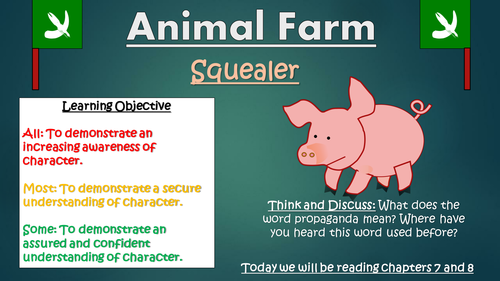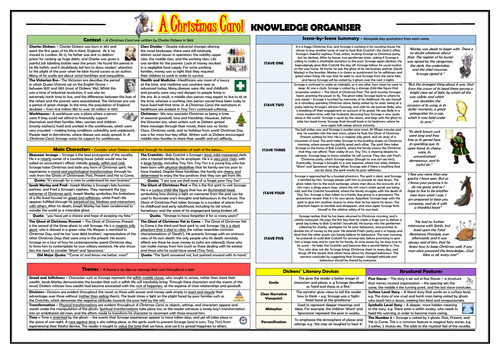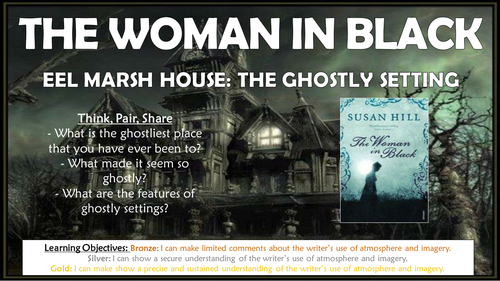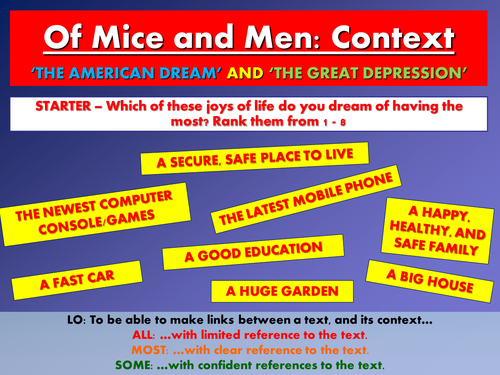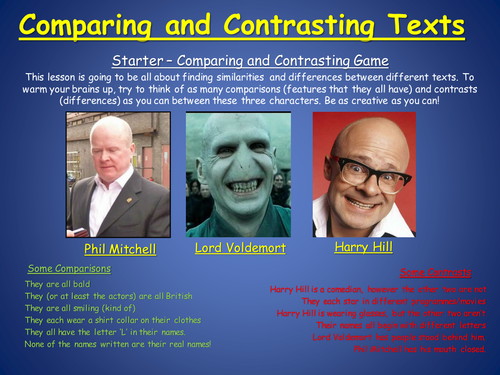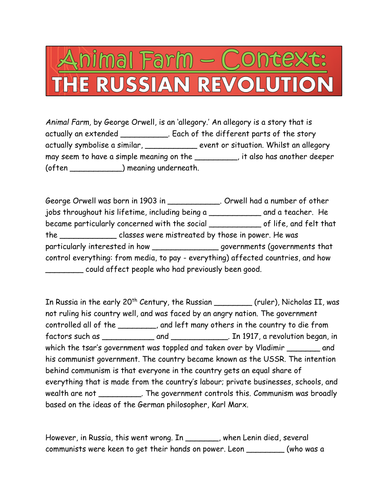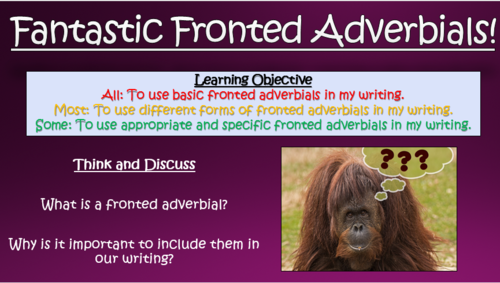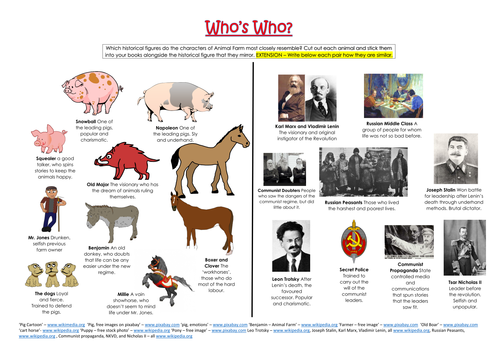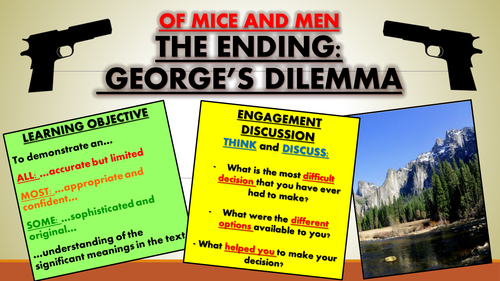
3k+Uploads
1969k+Views
2279k+Downloads
English

Animal Farm: Squealer (Double Lesson!)
These resources enable students to understand and analyse the character of Squealer in George Orwell’s Animal Farm. More precisely, students learn to make clear and accurate interpretations regarding his role in within the consolidation of Napoleon’s dictatorship. Students also demonstrate their understanding of chapters 7 and 8, with a particular emphasis upon the actions of Squealer. There are easily enough resources here for two lessons.
Students learn through the following tasks:
- Gauging and collaborating previous knowledge of 'propaganda' through a discussion-based starter task;
- Using an interactive, out-of-seat, group activity to build understanding of the features of propaganda;
- Reading chapters 7 and 8 with a particular focus on the character of Squealer, and demonstrating their understanding through a related activity sheet;
- Developing their understanding of Squealer's actions, and finding textual evidence to back this up, through a scaffolded, retrieval activity;
- Using their imaginative and creative skills, in addition to their knowledge of Squealer and propaganda posters, to construct their own propaganda poster for Animal Farm;
- Peer assessing their partners' learning attempts.
The following resources are provided:
- Engaging and colourful step-by-step PowerPoint
- Teacher lesson guidance/plan;
- Squealer's Propaganda worksheet;
- Four propaganda texts for group analysis;
- Template for recording group analysis;
- Chapters 7 and 8 worksheet (plus teacher answer sheet);
- Copies of Chapters 7 and 8.
All images and videos are licensed for commercial use, and are cited on the final slide of the PowerPoint.

A Christmas Carol Knowledge Organiser/ Revision Mat!
This detailed and visually-appealing resource offers a complete reference point for students learning or revising Charles Dickens' 'A Christmas Carol.' It contains comprehensive sections on:
- Context;
- Chapter by Chapter Summary (with quotes);
- Main Characters;
- Themes;
- Features of Structure;
- Dickens' Literary Devices.
Key words and ideas are underlined for easy reference. The resource is designed to be printed onto A3, and is provided as both a PDF and a Word version (so that you can edit if you want to). All images used are licensed for commercial use and are cited on a separate document (included).

Dr Jekyll and Mr Hyde Knowledge Organiser/ Revision Mat!
This detailed and visually-appealing resource offers a complete reference point for students learning or revising Robert Louis Stevenson's 'Strange Case of Dr Jekyll and Mr Hyde.' It contains comprehensive sections on:
- Context;
- Chapter by Chapter Summary (with quotes);
- Main Characters;
- Themes;
- Stevenson's Language Devices;
- Gothic Features.
Key words and ideas are underlined for easy reference. The resource is designed to be printed onto A3, and is provided as both a PDF and a Word version (so that you can edit if you want to). All images used are licensed for commercial use and are cited on a separate document (included).

The Woman in Black: Eel Marsh House - The Ghostly Setting!
This engaging and informative lesson enables students to make precise and sustained interpretations regarding Susan Hill’s portrayal of Eel Marsh House in the early chapters of The Woman in Black. In particular, they consider how the language (e.g. similes and pathetic fallacy) are used to introduce and develop the imagery and atmosphere of the house. They also consider how the features of the house (e.g. its isolation and age) relate to the generic conventions of scary settings.
The lesson follows a step-by-step learning journey, in which children learn through:
- Defining the key conventions of ghostly settings;
- Reading extracts introducing Eel Marsh House, and relating the conventions of ghostly settings to the description of Eel Marsh House;
- Identifying and exploring how the features of Hill's language help to create imagery and an atmosphere that surrounds Eel Marsh House;
- Analysing how Hill's language and subject matter are effective in the description of Eel Marsh House;
- Peer assessing each other's learning attempts.
Included is:
- Whole lesson PowerPoint - colourful and comprehensive;
- Extracts from 'The Journey North' and 'Across the Causeway' of The Woman in Black;
- The Features of Ghostly Settings worksheet;
- Analysis template with success criteria for creating well-structured responses;
- Comprehensive lesson plan.
There are also opportunities for group learning, peer assessment, and whole class discussion. This was originally taught to middle-ability year 10 groups, but can easily be differentiated for groups of different ages and abilities.
All images are licensed for commercial use, and image rights are listed on the last page of the presentation.

Of Mice and Men - Context: The American Dream and The Great Depression
This engaging and interesting lesson aims to improve students' knowledge of the social, historical, and cultural context of John Steinbeck's Of Mice and Men. It also aims to build their skills in creating clear and specific links between the text and it's context, focusing on a specific extract from the novel.
The lesson uses a range of tasks, that require students to use their visual and interactive skills. It follows this learning journey:
- Understanding what dreams are and how they differ for each of us;
- Defining the American Dream, The Wall Street Crash and The Great Depression;
- Creating a timeline which visually depicts the other influential events of the time;
- Reading and reflecting on an extract from the text;
- Analysing the links between texts and contexts, from a success criteria;
- Evaluating each others' analytical attempts.
All images in this resource are licensed for commercial use, and are cited on the final slide of the lesson presentation.
You can choose to buy this resource alone, or as part of the 'Of Mice and Men - All Lessons and Scheme' bundle, which contains seven full lessons, resources, teachers notes, and PowerPoint presentations, plus a Pointless Of Mice and Men game, for just £5!

New GCSE English Language - Comparing and Contrasting
This informative and engaging double lesson aims to improve students’ ability to compare and contrast two different texts based on a similar subject. They will focus particularly on the purpose, audience, language, and structure of texts, and will learn to use comparing and contrasting connectives to highlight any similarities and differences. This has always been a crucial skill in English, but has an increased importance in the new GCSE for English Language, as there is a greater requirement for students to be able to make links and comparisons between texts.
The lesson follows a clear and logical learning journey, with students learning to:
- Understand the key terms 'compare' and 'contrast', and the importance of these skills in English;
- Categorise the different features that they can compare, under the headings 'Purpose', 'Audience', 'Language' and 'Structure;'
- Read (and identify the key features within) two morally and ethically intriguing texts, offering diverse views of young people in the media;
-Compare the two texts, using a clear and concise template, and newly-acquired knowledge of different types of connectives;
- Peer-assess each other's comparative essay attempts.
Included in this resource pack are:
- Whole double lesson, colourful and engaging PowerPoint presentation (Including assessment for learning referral slides)
- Cards for card-sorting activity;
- Two interesting and thought-provoking non-fiction media extracts (one a newspaper extract from The Evening Standard, and another a persuasive leaflet, both focused on the issue of how young people are perceived.)
- Template for main comparative analysis task;
- Full teacher guidance plan.
All images are licensed for commercial use and are cited on the final slide of the PowerPoint presentation

Animal Farm: Context - The Russian Revolution
These resources enable students to understand the context of the Russian Revolution, the predominant subject of Orwell’s allegory within Animal Farm. More precisely, students learn about the key historical events and figures throughout this point in time in Russian history, and begin to comprehend Orwell’s intentions in writing the novella. These resources give students a strong foundation of knowledge which they can then utilise to begin confidently relating the text to its context. There are easily enough resources for at least two lessons within this resource pack.
Students learn through the following tasks:
- Gauging and collaborating previous knowledge through a discussion-based starter task;
- Watching, listening, and demonstrating their understanding of an engaging and informative context video and related activity sheet;
- Developing their understanding through in-depth investigative research into the main leaders of the Russian Revolution;
- Writing a letter from the viewpoint of a member of the Russian working class, who has lived through the various regimes and revolutions.
- Peer assessing their partners’ learning attempts.
The following resources are provided:
- Engaging and colourful step-by-step PowerPoint (includes links for video)
- Teacher lesson guidance/plan;
- Context worksheet;
- Five investigative research templates: Stalin, Lenin, Trotsky, Marx, and The Secret Police.
All images and videos are licensed for commercial use, and are cited on the final slide of the PowerPoint. Note - internet connection is needed for the video activity.

Fantastic Fronted Adverbials!
This engaging and detailed resource pack has been designed to make the learning of fronted adverbials (particularly prominent in the new curriculum) easily accessible, engaging and interesting for all children. Throughout the lesson, students learn to improve their skill at using appropriate, concise, and precise fronted adverbials within their own writing compositions. In addition to the comprehensive lesson, resources, and plan, it also includes a fronted adverbials writing mat to assist students in building their extended writing skills.
The lesson follows a clear, logical, bite-size learning journey, which guides students towards differentiated learning objectives. Over the course of this journey, they become able to:
- Define what fronted adverbials are;
- Identify fronted adverbials in sentences;
- Analyse and evaluate what it is that makes some fronted adverbials more effective than others;
- Write an extended piece with the employment of fronted adverbials;
-Peer/self-assess learning attempts.
This resource pack includes:
- A visually engaging whole-lesson PowerPoint presentation;
- A clear and interesting worksheet for the development task;
- An interesting short story for students to analyse;
- A hyperlink to an engaging and heart-warming video through a hyperlink in the presentation;
- A detailed lesson plan, complete with what the teacher and students should aim to achieve at each stage of the lesson.
All images are licensed for commercial use, and are cited on the final slide of the PowerPoint/ the bottom of worksheets.

Poppies - Jane Weir - Knowledge Organiser/ Revision Mat!
This detailed and visually-appealing resource offers a complete reference point for students learning or revising Jane Weir’s power and conflict poem 'Poppies.’ It contains comprehensive sections on:
Context;
Line-by-Line Analysis;
Poetic Devices/ Language Devices;
Themes;
Form/Structure;
Poems for Comparison;
The Poet’s Influences.
Key words and ideas are underlined for easy reference. The resource is designed to be printed onto A3, and is provided as both a PDF and a Word version (so that you can edit if you want to). All images used are licensed for commercial use and are cited on a separate document (included).

Macbeth: Act 2 Scene 2 - The Murder of King Duncan!
This lesson aims to improve students’ understanding of one of the key scenes in William Shakespeare’s Macbeth – Act II Scene II. In particular, they learn to make insightful interpretations about Shakespeare’s use of symbolism, and are enabled to understand how this would have affected Shakespearean audiences.
The lesson utilises a range of tasks, that require students to be visual and interactive learners. It follows this learning journey:
- Defining the key term 'symbolism' and establishing its importance as a literary technique;
- Understanding the different objects that were used as symbols in Shakesperean times through a multiple choice team game;
- Reading and interpreting Act 2 Scene 2, and establishing how symbolism is utilised throughout;
- Summarising the events of the scene;
- Analysing Shakespeare's intentions in using literary techniques, and considering the audience reactions to them;
- Peer/self evaluating the learning in the lesson.
Included in this resource pack are:
- A well-presented, thorough, and informative, whole-lesson PowerPoint presentation;
- Resources for the reading and interpreting activity - full scene transcript with space for notes;
- A template to help scaffold the main task, complete with P.E.E instructions;
- A comprehensive teacher guidance form/lesson plan to assist delivery.
All images in this resource are licensed for commercial use, and are cited on the final slide of the lesson presentation.

The Merchant of Venice - Act 4 Scene 1 - The Courtroom Scene!
This engaging and informative lesson enables students to make clear, detailed and well-informed interpretations of Act IV Scene I of The Merchant of Venice. In particular, students develop their understanding of the key events/ implications of the scene, identify and analyse the language devices used by Shakespeare within key quotations from the scene, and consider the effect of these choices on Shakespearean audiences.
The lesson follows a step-by-step learning journey, in which children learn through:
Engage with an artist’s impression of the courtroom scene, honing their skills of inference and deduction;
Reading and comprehending the main events and meanings in the courtroom scene;
Identifying and analysing Shakespeare’s use of language through examples of Portia and Shylock lines in the scene;
Considering Shakespeare’s intentions and the Shakespearean audiences reactions to the scene;
Self assessing their learning through the lesson;
Included is:
Whole lesson PowerPoint - colourful and comprehensive;
Language devices cards for the card-sorting activity;
Key quotations cards;
Copy of Act IV Scene I;
Shakespeare’s Intentions/ Audience Reactions template;
Comprehensive lesson plan.
Resources are provided in PDF (to maintain formatting), Word (so that they are easily editable) and also in zipfiles.
The lesson contains opportunities for group learning, speaking and listening, peer assessment, and whole class discussion. I originally used these resources with year 10 and 11 classes, however colleagues have used them for between year 9 and year 13 with some adaptations.
All images are licensed for commercial use, and image rights are listed on the last page of the presentation.

Animal Farm: Old Major's Dream and The Revolution!
These resources enable students to understand and analyse the Old Major’s dream and the events of the animal revolution, in the opening two chapters of George Orwell’s Animal Farm. More precisely, students learn to make clear and accurate interpretations about events and characters, with appropriate links to the Orwell’s allegory and relationship to context.
Students learn through the following tasks:
- Gauging and collaborating previous knowledge through a discussion-based starter task;
- Reading the first two chapters and demonstrating their understanding through a related activity sheet;
- Developing their understanding of characters and context through a a making links activity;
- Analysing the allegorical nature of the opening chapters by further exploring the connections between characters and contexts;
- Peer assessing their partners' learning attempts.
The following resources are provided:
- Engaging and colourful step-by-step PowerPoint (includes links for video)
- Teacher lesson guidance/plan;
- Chapters 1 and 2 worksheet;
- Making Links Activity Sheet (1x more difficult, 1 x easier);
- Copies of Chapters 1 and 2.
All images and videos are licensed for commercial use, and are cited on the final slide of the PowerPoint. Note - internet connection is needed if you plan to use the video.

Lord of the Flies Knowledge Organiser/ Revision Mat!
This detailed and visually-appealing resource offers a complete reference point for students learning or revising William Golding's 'Lord of the Flies.' It contains comprehensive sections on:
- Context;
- Chapter by Chapter Summary (with quotes);
- Main Characters;
- Themes;
- Golding's Language Devices;
- Features of Form.
Key words and ideas are underlined for easy reference. The resource is designed to be printed onto A3, and is provided as both a PDF and a Word version (so that you can edit if you want to). All images used are licensed for commercial use and are cited on a separate document (included).

Of Mice and Men: The Ending - George's Dilemma
This engaging and interesting lesson aims to improve students' knowledge of the final events of the novel (the killing of Lennie by his best friend, George) in John Steinbeck's Of Mice and Men. It also aims to build their skills in retrieving information from texts, understanding the writer's ideas and opinions, and making precise and confident interpretations about texts.
The lesson uses a range of tasks, that require students to use their visual and interpersonal skills. It follows this learning journey:
- Reading, and interpreting the ending of the text;
- Inferring the hidden meanings in the final section of the text;
- Identifying the options available to George, and evaluating the pros and cons for each of them;
- Arguing a viewpoint either justifying or condemning George's actions;
- Evaluating each others' argumentative attempts.
The resource includes a comprehensive and visually engaging PowerPoint presentation, a worksheet to evaluate George's reasoning, an abstract from the text, a help-sheet for writing to analyse, and a lesson plan/ teacher guidance sheet.
All images in this resource are licensed for commercial use, and are cited on the final slide of the lesson presentation.
You can choose to buy this resource alone, or as part of the 'Of Mice and Men - All Lessons and Scheme' bundle, which contains seven full lessons, resources, teachers notes, and PowerPoint presentations, plus a Pointless Of Mice and Men game, for just £5!

The Charge of the Light Brigade Knowledge Organiser/ Revision Mat!
This detailed and visually-appealing resource offers a complete reference point for students learning or revising Alfred, Lord Tennyson’s power and conflict poem 'The Charge of the Light Brigade.’ It contains comprehensive sections on:
Context;
Line-by-line Analysis;
Poetic Devices/ Language Devices;
Themes;
Form/Structure;
Poems for Comparison;
The Poet’s Influences.
Key words and ideas are underlined for easy reference. The resource is designed to be printed onto A3, and is provided as both a PDF and a Word version (so that you can edit if you want to). All images used are licensed for commercial use and are cited on a separate document (included).

Emily Dickinson - Knowledge Organiser!
This clear, detailed and visually-appealing resource offers a complete reference point for children learning about Emily Dickinson, particularly those studying her works in English or completing a history study of ‘Significant Individuals.’ It contains comprehensive sections entitled:
Overview;
Times in Her Life;
Important Vocabulary;
Emily Dickinson Timeline;
Answers to the Important Questions;
Top Ten Facts.
The resource is designed to be printed onto either A4 or A3, and is provided as both a PDF and a Word version (so that you can edit if you want to). All images are licensed for commercial use.

Virginia Woolf - Knowledge Organiser!
This clear, detailed and visually-appealing resource offers a complete reference point for children learning about Virginia Woolf, particularly those studying her works in English or completing a history study of ‘Significant Individuals.’ It contains comprehensive sections entitled:
Overview;
Times in Her Life;
Important Vocabulary;
Virginia Woolf Timeline;
Answers to the Important Questions;
Top Ten Facts.
The resource is designed to be printed onto either A4 or A3, and is provided as both a PDF and a Word version (so that you can edit if you want to). All images are licensed for commercial use.

William Wordsworth - Knowledge Organiser!
This clear, detailed and visually-appealing resource offers a complete reference point for children learning about William Wordsworth, particularly those studying his works in English or completing a history study of ‘Significant Individuals.’ It contains comprehensive sections entitled:
Overview;
Times in His Life;
Important Vocabulary;
William Wordsworth Timeline;
Answers to the Important Questions;
Top Ten Facts.
The resource is designed to be printed onto either A4 or A3, and is provided as both a PDF and a Word version (so that you can edit if you want to). All images are licensed for commercial use.

Lewis Carroll - Knowledge Organiser!
This clear, detailed and visually-appealing resource offers a complete reference point for children learning about Lewis Carroll, particularly those studying his works in English or completing a history study of ‘Significant Individuals.’ It contains comprehensive sections entitled:
Overview;
Times in His Life;
Important Vocabulary;
Lewis Carroll Timeline;
Answers to the Important Questions;
Top Ten Facts.
The resource is designed to be printed onto either A4 or A3, and is provided as both a PDF and a Word version (so that you can edit if you want to). All images are licensed for commercial use.

Animal Farm: Dictatorship
These resources enable students to understand and analyse the characteristics of Napoleon’s dictatorship in George Orwell’s Animal Farm. In addition, students learn to make clear and accurate interpretations regarding the events of the chapters 5 and 6, (as Napoleon’s dictatorship begins to emerge) and make appropriate links to individual characters and their allegorical relationship to context. As these chapters signal the end of the animal democracy on the farm, and the start of Napoleon's totalitarian dictatorship, a heavy emphasis throughout these resources is placed upon the character of Napoleon - particularly with regards to his similarities with Joseph Stalin.
There are easily enough resources for two lessons within this pack. Students learn through the following tasks:
- Gauging and collaborating prior knowledge through a discussion-based starter task;
- Gauging their knowledge of key terms such as 'totalitarian' and 'oppression' through a collaborative card-sorting activity;
- Reading chapters 5 and 6 and demonstrating their understanding through an apt and informative worksheet;
- Developing their understanding of the main character of Snowball, and his allegorical equivalent, Joseph Stalin, through a comparison task;
- Analysing the links between Napoleon and Stalin in chapters 5 and 6, using a templated writing frame;
- Peer assessing their partners' learning attempts.
The following resources are provided:
- Engaging and colourful step-by-step PowerPoint;
- Cards for card-sorting activity;
- Teacher lesson guidance/plan;
- Analytical paragraphs worksheet;
- Pictures for comparison task;
- Copies of Chapters 5 and 6.
All images are licensed for commercial use, and are cited on the final slide of the PowerPoint.

